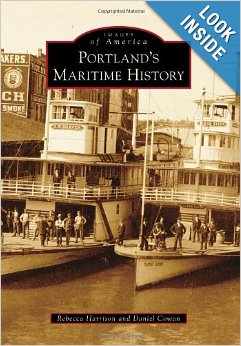 Portland is not only the site of numerous marine terminals along the Willamette and Columbia Rivers, but is also home to much of our American maritime history. Portland shipbuilding started in 1840 with construction of the schooner the Star of Oregon. Over 100 years later, three Portland shipyards would build 621 ships for the war effort. Both before and after World War II, several steel and iron companies used the harbors in Portland for their manufacturing. Aside from production, Portland ships over 13 million tons of cargo every year and is the biggest shipper of wheat in the United States. The city displays this maritime history along its beautiful rivers.
Portland is not only the site of numerous marine terminals along the Willamette and Columbia Rivers, but is also home to much of our American maritime history. Portland shipbuilding started in 1840 with construction of the schooner the Star of Oregon. Over 100 years later, three Portland shipyards would build 621 ships for the war effort. Both before and after World War II, several steel and iron companies used the harbors in Portland for their manufacturing. Aside from production, Portland ships over 13 million tons of cargo every year and is the biggest shipper of wheat in the United States. The city displays this maritime history along its beautiful rivers.
This book can be purchased via Arcadia Publications, http://www.arcadiapublishing.
It is also available through Ingram and at Amazon.
http://www.amazon.com/
For more information, check out my website for Portland’s Maritime History at:
http://portlandmaritime.
Deep Dark and Dangerous: On the Bottom with the Northwest Salvage Divers is still readily available through Ingram and Amazon and many booksellers.
Salvage divers work underwater in a blinding darkness. In their cumbersome diving gear, these men have barely enough room to move around, while at the same time fighting the cold temperatures and fast currents. It is a dirty, unromantic and highly dangerous way of earning a living. Yet, these divers would not have traded their jobs for any other profession. From locating sunken boxcars to repairing concrete foundations for bridges, no task is too risky. Any underwater salvage or repair work becomes the job of these elite divers. Salvage divers must be carpenters, masons, riggers, hydraulic mechanics, ironworkers, welders, pile bucks and underwater engineers. They must be able to adapt all blueprints, tools and equipment to the harsh realities of the underwater environment.
For more information, check out my website for Deep Dark and Dangerous: On the Bottom with the Northwest Salvage Diversat: www.deepdarkanddangerous.com



![[BOOKS] “Portland’s Maritime History” is now available Portland Maritime History](https://www.thescubanews.com/wp-content/uploads/2014/01/portlandmaritimehistory-bookcover.jpg)



